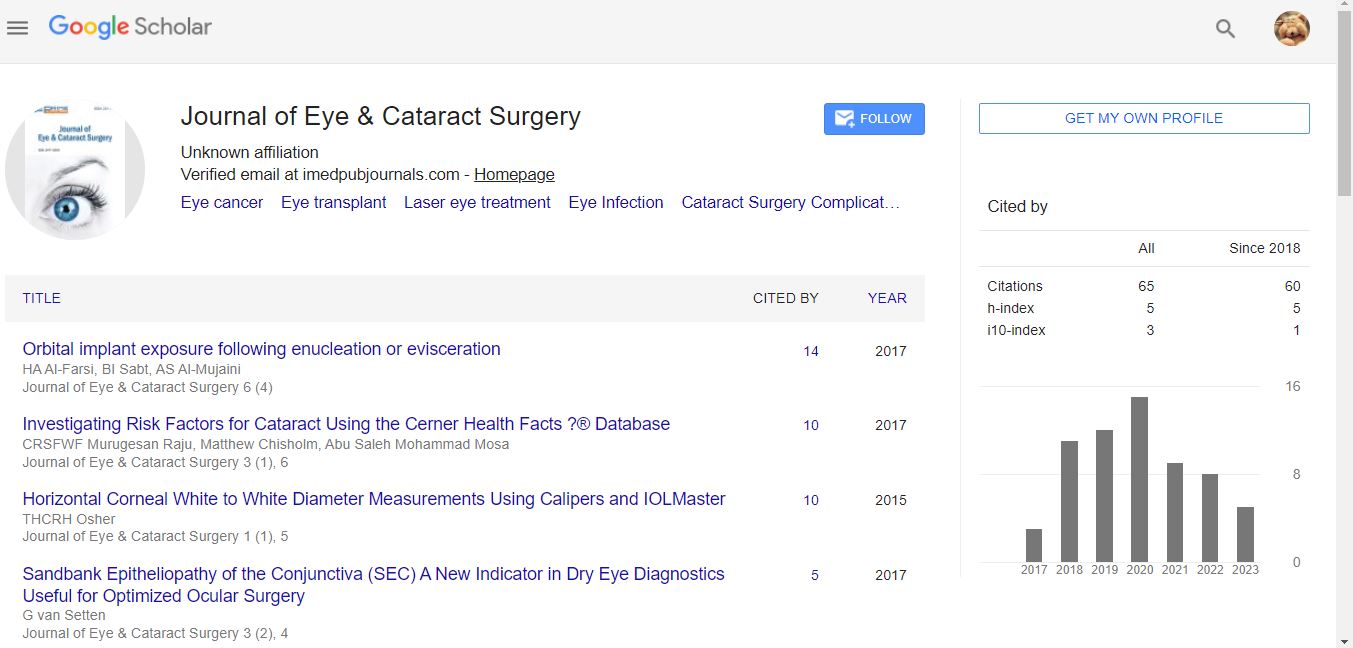Commentary - (2024) Volume 10, Issue 3
An In-Depth Analysis of Conjunctivitis: Causes, Symptoms and Diagnosis
Quinn Julia*
Department of Ophthalmology, University of Global Health, USA
*Correspondence:
Quinn Julia,
Department of Ophthalmology, University of Global Health,
USA,
Email:
Received: 02-Sep-2024, Manuscript No. IPJECS-24-21683;
Editor assigned: 04-Sep-2024, Pre QC No. IPJECS-24-21683 (PQ);
Reviewed: 18-Sep-2024, QC No. IPJECS-24-21683;
Revised: 23-Sep-2024, Manuscript No. IPJECS-24-21683 (R);
Published:
30-Sep-2024, DOI: 10.36648/2471-8300.10.3.23
Description
Conjunctivitis, commonly known as pink eye, is an inflammation
of the conjunctiva, the thin, transparent membrane that covers
the white part of the eye and lines the inner surface of the
eyelids. This condition is prevalent across all age groups and
can be caused by various factors, including infections, allergies,
irritants, and underlying medical conditions. Understanding the
various types of conjunctivitis, their symptoms, and treatment
options is crucial for effective management and prevention.
The most common form of conjunctivitis is viral conjunctivitis,
often resulting from adenoviruses, which are highly contagious
and can spread rapidly in communal settings such as schools
and day-care centres. Symptoms of viral conjunctivitis typically
include redness, watery discharge, and a gritty sensation in
the eye. Unlike bacterial conjunctivitis, which often produces
thicker, yellow or green discharge, viral conjunctivitis usually
presents with clear discharge. It is important to note that while
viral conjunctivitis is self-limiting and typically resolves within
one to two weeks, symptomatic relief can be achieved through
cool compresses and artificial tears to alleviate discomfort.
This type can also be highly contagious and is characterized by
a sudden onset of redness, swelling, and a purulent discharge
that may crust the eyelids, especially after sleep. Prompt
treatment with antibiotic eye drops or ointments is essential to
control the infection and prevent complications. While bacterial
conjunctivitis often resolves within a week with appropriate
treatment, untreated cases can lead to serious complications,
including corneal involvement. Allergic conjunctivitis occurs in
response to allergens such as pollen, dust mites, pet dander, or
mold. It is characterized by intense itching, redness, swelling,
and watery discharge. Unlike viral and bacterial forms, allergic
conjunctivitis is not contagious. Management typically involves
avoiding known allergens, using antihistamine eye drops, and
employing cool compresses to reduce itching and swelling.
In chronic cases, more robust treatments such as mast cell
stabilizers or corticosteroid drops may be necessary, particularly
when allergies are persistent. Healthcare providers may
prescribe topical anti-inflammatory medications if symptoms
persist. In some cases, laboratory tests may be required to
identify specific pathogens, particularly in persistent or severe
cases. Prevention of conjunctivitis largely revolves around good
hygiene practices. Handwashing with soap and water, avoiding
touching the eyes, and not sharing personal items such as towels
or makeup can significantly reduce the risk of transmission. For
individuals with allergic conjunctivitis, minimizing exposure
to known allergens is crucial. Wearing protective eyewear in
environments with irritants can also help. Education plays a
vital role in managing conjunctivitis effectively. Patients should
be informed about the nature of their condition, appropriate
treatment options, and when to seek further medical care. For
instance, patients should be aware that while viral conjunctivitis
is self-limiting, bacterial conjunctivitis necessitates antibiotic
treatment to prevent complications. In conclusion, conjunctivitis
is a common yet multifaceted condition that can significantly
affect quality of life with the right approach most cases can be
treated successfully, enabling patients to regain comfort and
clear vision. As ongoing research continues to enhance our
understanding of conjunctivitis, improved diagnostic tools and
treatment options will further benefit those affected by this
prevalent eye condition.
Acknowledgement
None.
Conflict Of Interest
None.
Citation: Julia Q (2024) An In-depth Analysis of Conjunctivitis: Causes, Symptoms and Diagnosis. J Eye Cataract Surg. 10:23.
Copyright: © 2024 Julia Q. This is an open-access article distributed under the terms of the Creative Commons Attribution Li�cense, which permits unrestricted use, distribution, and reproduction in any medium, provided the original author and source
are credited.

